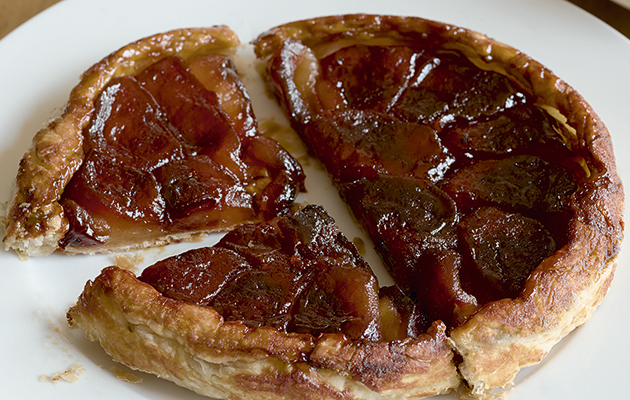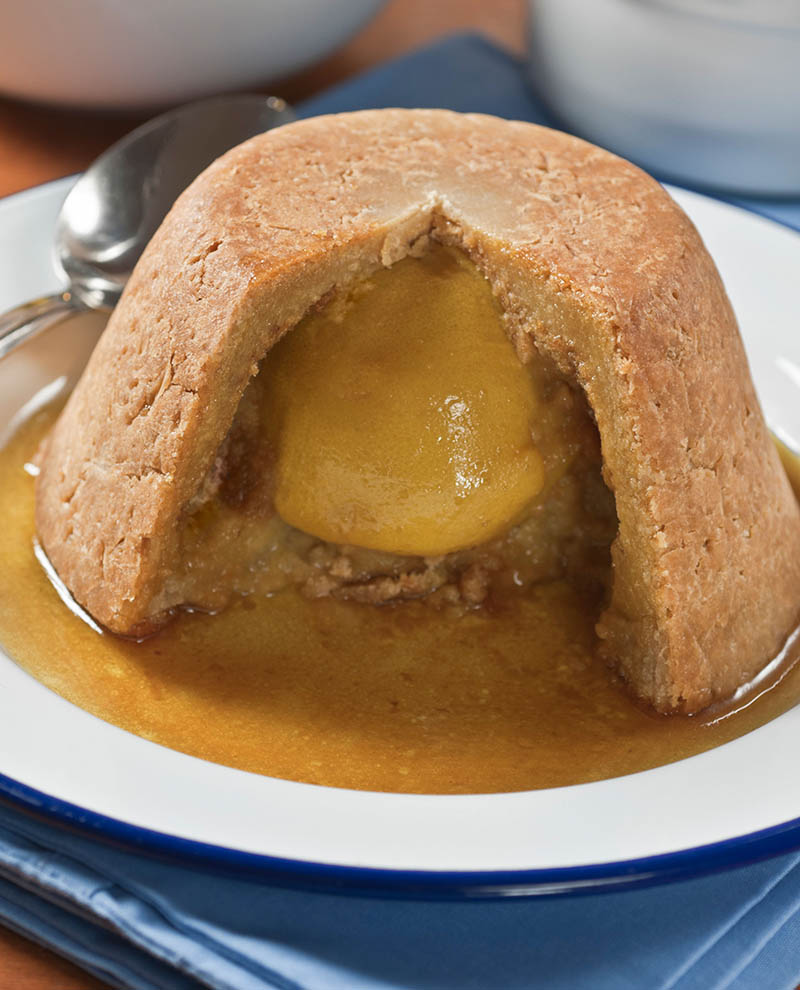How to make Tarte Tatin and 'Apple Hat' pudding this autumn
Simon Hopkinson suggests two sumptuous apple puddings for autumn: tarte tartin and 'apple hat'.


Simon Hopkinson's Tarte Tatin
My cooking chum Rowley Leigh always insists on using Cox’s apples to make his tarte Tatin. Although I love the flavour of a Cox, they can, occasionally, ‘blow’ when cooked, in a similar way to a Bramley; the latter is intended to do this, which is just fine, but, for the tart, one needs a guarantee of fruit that remains compact during the cooking process.
When one thinks about it, once the apple has been intensely caramelised to within an inch of its life, its original taste has been somewhat bullied into submission. The Golden Delicious wins on performance here, I’m afraid, in favour over flavour.
Ingredients (Serves 4)
- Serves 4
- 6–7 Golden Delicious apples
- 40g butter
- 40g caster sugar
- 200g all-butter puff pastry, rolled into a circle to fit the width of the pan
Method
Peel the apples and then cut them in half from stem to base. Using a melon baller (without doubt, the best implement), remove the core in one swift movement, so creating a clean and smooth half-moon crater, then nip out the stem and base parts using the same implement. Now, cut each half into quarters.
Melt the butter in a deep-sided pan (a cast-iron frying pan is ideal, about 20cm–22cm wide by 4cm deep) and stir in the sugar. Allow to bubble a little and remove from the heat. Pre-heat the oven to 200˚C/400˚F/gas mark 6.
Cool the contents for a few minutes and then arrange the apple quarters (rounded side down), slightly overlapping, until the pan is tightly packed with the fruit. Place over a low heat and patiently wait until the exuding apple juices mingle with the melted butter and sugar, then leave to happily bubble away until a golden caramel begins to emerge around the edges of the pan; this can take as much as 30 minutes to appear.
Remove from the heat, leave to cool for about 10 minutes, then flop the circle of puff pastry over the apples and tuck in the edges around the edge of the pan. Generously prick the surface of the pastry with a fork and place in the oven for about 25 minutes or so, until the pastry is golden brown and crisp.
Remove from the oven and deftly invert the contents onto a large plate, taking care to protect one’s hands with a tea towel should any stray dribbles of caramel escape during this brave procedure.
Exquisite houses, the beauty of Nature, and how to get the most from your life, straight to your inbox.
Serve warm or at room temperature, with lightly beaten, lightly sweetened, lightly vanilla-scented whipped cream.
Simon Hopkinson's Apple hat pudding
The recipe here is based on one from a National Trust cookery book, lovingly written and compiled by Sara Paston-Williams. For me, it will always be my Bible when wishing to unearth traditional English puddings.
As far as I know, it is here that one will further find the original recipe for Bakewell pudding, a far cry from what later became the ubiquitous Bakewell tart.
There is also a local variation called the 'Sussex Pond' pudding, a similar suet pudding with a lemon inside, steamed for hours.

Anyway, onto the hat.
Ingredients (serves 4–6)
For the suet pastry
- 250g self-raising flour
- 180g suet
- Quarter tspn salt
- 60g fresh white breadcrumbs
- Half tspn baking powder
- 125ml–150ml skimmed milk
- 750g cooking apples (Bramley)
- 50g raisins or sultanas
- 75g soft brown sugar
- 3–4 cloves
- Big pinch of both cinnamon and ground ginger
- Grated rind and juice of half a lemon and half an orange
- 50g salted butter
Method
Generously butter a one-litre pudding basin. Sieve flour into a mixing bowl. Stir in the suet, salt, breadcrumbs and baking powder, then mix with sufficient milk to make a soft, light dough. Knead lightly and roll out onto a floured board to a thickness of about 0.5cm.
Prepare two-thirds of the pastry to line the basin, leaving the remaining one-third for the lid—roll each into circles, one that will fit the inside of the bowl (the larger) and the other to form the lid (the smaller). Peel, core and slice the apples into a basin, add the raisins (or sultanas), sugar and spices. Stir in the lemon and orange rind with their juices, together with the butter, cut into small pieces.
Line the buttered basin with the two-thirds of the pastry, fill with the fruit mixture and then cover the basin with the smaller disc of pastry, dampening the edges and pressing together firmly.
Cover with a piece of well-buttered, pleated greaseproof paper followed by a piece of similarly buttered foil with a further pleat, but placed at right angles to the greaseproof to allow the pudding to rise. Tie around securely with string. Steam for 2–2½ hours.
Turn out onto a warmed serving dish and serve hot, with thick double cream or custard.
